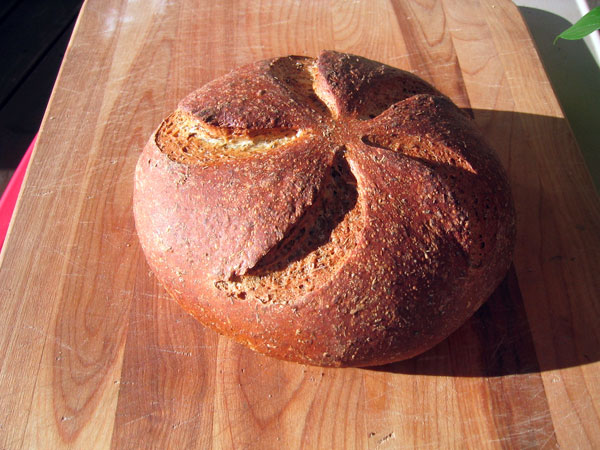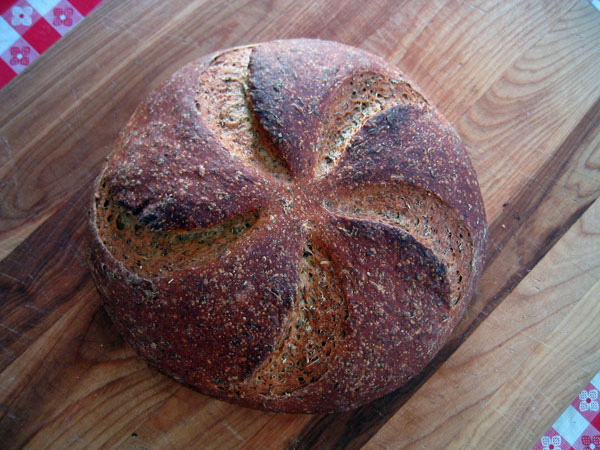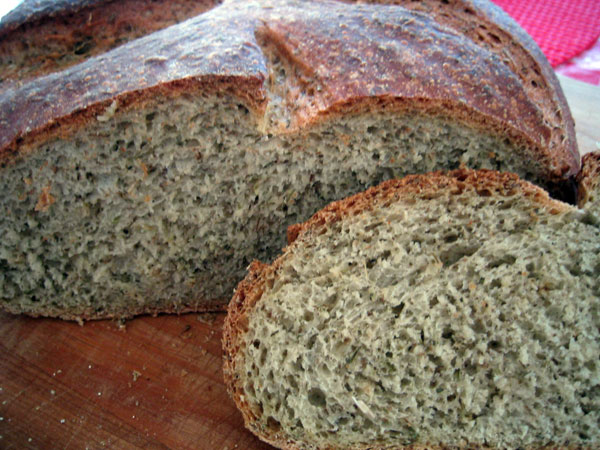
It is getting to be harvest season in my part of the world, and that means herbs are cheap and plentiful. Now is a great time to try baking an herb bread.
You can bake wonderful herb breads with whatever you have on hand: rosemary, dill, basil, thyme, mint, chives, you name it. I happen to have an excess of Herbes De Provence on hand, a mixture of savory, thyme, fennel, and lavender that you can find in most specialty grocery stores or order online.
I used my standard poolish french bread as the base for this, then added the liqueur and herbs recommended by Bernard Clayton in his recipe for Pain de Provence in his Complete Book of Breads. Feel free to experiment and use a different dough as the base.

Pain De ProvenceMakes 1 large loaf
Poolish:
1 cup bread or all-purpose unbleached flour
1 cup water
1/2 teaspoon instant yeastDough:
All of the poolish
2 cups bread or all-purpose unbleached flour
1/2 cup Herbes de Provence
1 1/2 teaspoon instant yeast
1 teaspoon salt
1/4 cup liqueur such as Beauchant, Grand Marnier, or orange Curaçao
1/4-1/2 cup water, as necessary
The night before baking, make the poolish by mixing together 1 cup of flour, 1 cup of water, and 1/2 teaspoon of yeast to make a batter. Cover the container with plastic wrap and set aside for 8 to 16 hours until you are ready to make the final dough.
To make the dough, combine the remaining flour with the remaining yeast, salt, and herbs. Add the poolish, the liqueur, and 1/4 cup of the additional water. Mix the ingredients, and, if necessary, add more water or flour until the proper consistency is reached (tacky but not so sticky that the dough sticks to your hands).
Knead by hand for 10 to 15 minutes or in a mixer for 5 to 10 minutes. Place the dough in a well-greased bowl and cover the bowl with plastic wrap. Set aside to rise until doubled in size, approximately 90 minutes. Remove it from the bowl and gently degas it, then return it to the bowl, cover it, and allow it to double in size again.
Remove the dough from the bowl and shape it into a ball or long loaf. Cover the loaf with a damp towel and allow it to rise again until doubled in size, which takes between 60 and 90 more minutes.
While the loaf is in its final rise, preheat the oven and baking stone, if you are using one, to 450. I also preheat a brownie pan into which I pour a cup of hot water just after placing the loaf in the oven. This creates steam in the oven which increases the crunchiness of the crust.
Just prior to placing the loaf in the oven, score the top of it with a sharp knife or razor blade.
Place the loaf in the oven and bake for 20 minutes at 450, then rotate it 180 degrees and reduce the oven temperature to 375 and baked it another 25 minutes. The internal temperature of the loaf should be in the ball park of 200 degrees when you remove it from the oven.
Remove from the oven and allow to cool for at least a half an hour before serving, if you can resist.

I couldn't.
Pain de Provence
- Log in or register to post comments
- Printer-friendly version


Comments
OMG, Floyd, that is such a beautiful loaf of bread! It is absolutely perfect, including the spacing of the slashes. What did you use to do your slashing--a lame with a curved blade, or just a straight blade of some sort? The eye appeal is just wonderful.
About the bread--isn't 1/2 cup of herbs a lot? How did it taste? Are you talking fresh herbs (more bulk) or dried? Sorry for all the questions, but I really love the looks of your loaf.
I can't believe it took me a week to find this post. I have my computer set to go automatically to the forums page from a link in my favorites. I think I'm going to have to change that because I'm missing out on the home page.
Thank you for the compliments. I agree, this probably was the prettiest loaf of bread I've ever baked. I hope I can pull it off again! :)
To score the top I used a cheapo, homemade curved lame:
The handle is a coffee stirring stick courtesy of Starbucks, the blade just a double-edged razor blade.
Typically I am awful at scoring loaves-- you'll notice I haven't done a lesson on scoring yet... that's because I'm not confident enough doing it to give anyone advice yet-- but I got lucky this time. I think part of why it worked out well is that the dry herbs absorbed enough water to make the dough fairly stiff, which makes scoring a heck of a lot easier.
I had the same thought, that a half a cup of herbs would be too much. But Herbes de Provence are pretty mild, and I really didn't find the flavor to be overwhelming. Sure, the herbs definitely dominated the loaf, but that was the point.
Beautiful loaf Floyd! I just wanted to say that I made this
today and it is awesome. I think the lavender in the herb mix is
what makes it incredible, the aroma while cooking is heavenly
and the flavor after is wonderful. Most definitely a favorite!
Thank you..
Oh..PS..I didn't have any orange liquer..so I used a raspberry
liquer I made last summer..very subtle taste. Pleasant flavor,
but I don't think it is necessary to still come out with an
excellent loaf..it's not what makes this a winner. As you said,
a splash of OJ or water would be just fine.
In spite of being on weightwatchers now, I'm going to make this tonight. I entered the ingredients in the ww points calculator, and if I can make it into 20 servings, it's only 2 points per serving, and Amy will be home to help me demolish it, so the damage won't be entirely on my hips.
Anyway, I don't have a suitable liqueur, only some questionable Irish creme. Do you think it contributed significantly to the bread, or should I be okay just using water to make up the extra liquid? Or maybe I should add a spot of sugar or maybe molasses to the mix?
I couldn't taste the liqueur. The flavor of the herbs totally overwhelmed it. I would just substitute in water or a splash of orange juice.
water it'll be, then, unless I go out today. not a drop of OJ in the house, either.
I'm looking for an herb bread because I have an abundance of fresh basil, rosmary and thyme in the garden right now, but I'm not sure how this would work out with fresh herbs. I think you're supposed to double the amount of herbs if you're using fresh, but how do you think that would work out. A cup of herbs?
I find my fresh herbs are stronger and have better aroma than dried ones. But I prefer to mix them in cream cheese or cottage cheese and spread them on the bread. Mini Oven
I ended up using the Italian bread recipe from BBA as a base, and then I added basil, rosemary and thyme. I'm guessing it's about a Tbsp of each. I should have hot bread in about 4 hours now. I'll start a new thread to post the results.
I agree. Great loaf Floyd. Looks great!
http://sugarwerks.myikonboard.com
Floyd, did you refrigerate the poolish or leave it on the counter overnight?
love the site.
SDbaker
I leave my poolish on the counter.
Ruth Redburn
How do I find some of these recipes mentioned in the comments? I would like to find a good Italian bread recipe like we had in Italy. Thanks, Ruth
I've only been baking for a couple weeks now, but love doing it.
I tried out the Pain de Provence today. My shaping and scoring need some work and I probably took it out of the oven a bit soon but it was 200F in the middle when I did.
Here's the results.
How did you like it? I think it's a great loaf..
I live in the UK and have tried to convert the cups to grams. My calculations (if correct) show that the flour is 360g and water is 284g - 340g. This ratio would give a very wet dough! And this is not including the liquer.
Whilst I realise that more water creates a more open texture, this recipe would appear very wet. A traditional baguette recipe would use 58g - 64g water for every 100g flour.
Please advise accordingly.
Thanks
I haven't done this recipe, but here are a couple of things to consider.
I would bet the cups would convert better to weight at about 140g/cup. I'm not sure what Floyd uses for his conversions, but Bernard Clayton's book, in which this recipe appears, has a table in the back that says 1 cup of flour is 142g. It probably makes sense to use that conversion ratio. Unfortunately, volume measures vary over a wide range for flour, since people have different methods of packing the flour. I've seen estimates by different authors of anywhere from about 110 grams to about 155g of flour to the cup.
Another factor is that the spices in this bread may absorb some water. I could imagine a half cup of spices absorbing an ounce or two of water.
Overall, if you use 142g/cup, that's 426g of total flour. If you add the water and liqueur together for 12 total ounces (using the lower water estimate), that's 340g of liquid. Subtract from that 30g of water absorbed by the spices, and you get 310g, which if divided by 426g, is a hydration of 73% or so. It's still a little higher hydration than I would've thought, but maybe the spices use more water than I'm guessing in this example.
One last thing is that flours vary over a fairly wide range in terms of the water they need to absorb for a given consistency. So, what may seem a reasonable consistency, using the proportions in the recipe, to someone using a flour available here in the US, may not seem the same for the flour you're using in the UK. So, some experimentation will be inevitable, given we all have access to somewhat different flours.
Bill
Hey Floyd,
How'd you get that great color on the loaf? I looked over everyone else's pics and theirs is more white rather than the rich brown color. Do you think it was the liqueur that enriched the color? I saw that you didn't think it affected the taste, but what about color?
Thanks!
David
ONe of my all-time favorite breads has been the rosemary and olive oil loaf from, of all places, Costco stores in California. I loved broiling portabella mushrooms, blackened red bell peppers & cheese on top for a delicious open-face sandwich. I am very excited to make my own with rosemary & sourdough, I have a feeling it will be even better than the loaf I have bought while in the U.S. The challenge is, of course, trying to find rosemary here. I would love to use fresh, but if not fresh, than at least not ground. So we'll see.
Just made a loaf of this amazing bread - thanks, Floyd! - and those who want to take a peek at my production, can jump here
http://bewitchingkitchen.com/2011/05/04/pain-de-provence/
Keep in mind I'm baking in a small oven and had to adapt the recipe to make a smaller batch. I also had some issues with my improvised method for generating steam, and butchered the top of my loaf right when it went into the oven
but, the bread survived my attempts at ruining it! :-)
Thanks for the great recipe, and guidance on this fabulous loaf. I did ease up on the herb quantity, but given how it perfumed the house and then became a memory, my family and I didn't think it was a loss. Perfect crust too with my first attempt at steaming. Again...Thanks! A keeper for sure.
I have GOT to try this recipe. Thank you!
So beautiful! On my list and bookmarked! Do you use a template for slashing?
10.5 years later and no one can replicate the color of the beautiful loaf that inspired so many others! I have no idea if you're reading these comments, but looking through them I see the most common theme is "Wonderful bread but mine is pale", and I share that sentiment. Any suggestions for improving the color? Did you wash the bread in something? Mine is baking just fine, 200F+ degrees inner temperature after the recommended baking time, and nowhere near that beautiful toasted brown in the photos. This is the third time I have baked it, and it's yummy for sure, but I want it to be beautiful, too! :)
Hope this works - trying to post two photos of today's loaf. Thank you for the recipe!
My version turns out looking somewhat like the author's. I have made it several times over the years; great recipe. 1 cup of the flour was a mix of 3/4 C whole wheat flour and 1/4 C wheat bran. I use rosemary but didn't have enough, so I filled the rest of the half-cup with the zest of two oranges. When I place the loaf in the oven, I also put in, on another shelf in the oven, a 8x8" brownie pan with 1 cup of boiling water in it (I microwave the water in a Pyrex glass measuring cup). The steam helps make a good crust. After scoring the top of the loaf, I paint on an egg wash (1 egg + 1 T water, mixed in a small bowl - don't paint on all of it; just enough to cover the loaf).